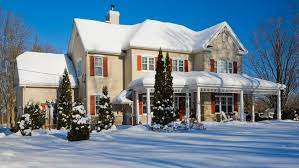
It wouldn’t be Christmas season without a deluge of snow and ice. Unfortunately, this weather can also wreak havoc on your home’s exterior. Doors that don’t close properly, windows that won’t close, and gutters that overflow are all common problems in the winter. we will show you how to winterproof your home’s exterior and keep it safe from the cold weather. We will discuss tips for caulking doors and windows, installing gutters, and more.
Table of contents
- What to Do Before the Winter Storm
- Protecting Your Home from the Elements
- Preparation Tips for a Winter Storm
- Winterizing Your Home
- Conclusion
What to Do Before the Winter Storm
If you live in a warm climate, you may not have to worry about winter weather. But for those of us who live in colder climates, preparations for the cold are essential. Here are four things you can do to prepare your home for winter weather:
1. Clean and declutter your home. This will make it easier to keep track of things during the winter weather and help reduce clutter that can lead to damage from the elements.
2. Make sure all your doors and windows are properly sealed. This will prevent wind and snow from coming inside and costing you money on heating and cooling bills.
3. Clear any debris or leaves from around your property’s foundation and outside walls. This will help protect them from erosion caused by snow or ice accumulation over time.
4. Install a proper system of insulation in your home. This will help keep your home warm in the cold months, while also reducing energy costs overall
Protecting Your Home from the Elements
When it comes to protecting your home from the elements, there are a few things you can do. One way is to seal any cracks in the exterior with caulk or silicone. This will help keep weather and water out of the house. Another step you can take is to install caulking around windows and doors, and around pipes that run into the house. Doing this will help keep moisture and cold air out, and will also protect your home from damage in bad weather. If you live in an area that experiences lots of snow or ice, you may also want to consider installing a roof protection system like shingles or tiles. These systems work by trapping snow and ice on the roof, keeping it off of your home’s interior.
Preparation Tips for a Winter Storm
When a winter storm is predicted, take steps to protect your home. Here are preparation tips for a winter storm:
1. Check the weather forecast and plan your routes accordingly. If you need to leave quickly, do so! Traffic will be heavy and access to essential services may be limited.
2. Have an emergency evacuation plan in place. Know where you would go if you had to leave quickly and have supplies ready to go. Include family members who live out of state or country in your plans as well.
3. Secure outdoor plants and decorations. Strong winds can knock over trees and power lines, rendering your home uninhabitable or dangerous. Protect outdoor assets by securing fences, uprooting large plants, and wrapping Christmas lights around poles.
4. Check Your Smoke Alarms & Heat Pumps: Make sure smoke alarms are working properly and that heat pumps are running if you will be using them during the storm (heating systems accumulate ice during freezing temperatures).
5. Clear paths for snow removal: Make sure there is plenty of room for equipment on all sides of the house, clear walkways around the property, and remove any objects that could cause damage (such as tree limbs).
6 .Secure Your Home: Close windows and doors securely; secure gutters; coil power cords; tie down loose items; pack heavy items near the foundation or inside walls; turn off utilities at the main breaker box if possible; put sandbags around
Winterizing Your Home
If you live in a climate where winters can be cold and wet, it’s important to take some preventative measures to help your home weather the elements. One key way to ensure your home is properly winterized is by doing some exterior maintenance, like sealing the doors and windows, caulking cracks and joints, and installing an effective insulation system. Here are five tips for winterizing your home:
Seal Doors and Windows: A good way to keep out moisture and pests is to seal all of the exterior doors and windows. This will help keep cold air out while keeping heat in during colder months. If your home has drafty doors or windows, consider adding thermal curtains or window coverings to help insulate your home during cold weather.
Caulk Cracks and Joints: Caulking around door and window frames, around chimneys and vent pipes, as well as around any openings that could allow water or snow inside (like crawl spaces), will help prevent drafts from coming in while also keeping water and snow out. Make sure you use a high-quality caulk that can handle exposure to the elements; low-quality caulk may not withstand the winter weather conditions.
Install an Insulation System: Another key way to keep your home warm during colder months is by installing an effective insulation system. There are a number of different types of insulation available on the market today, so it’s important to choose one that’s going
Conclusion
When the weather outside gets cold, it’s important to take measures to protect your home from frostbitten pipes and unhoused pets. Here are five tips for winterproofing your exterior: 1. Insulate Your Home Properly – One of the best ways to prevent frostbite on your home is by properly insulating it. Consider using spray foam insulation or batt insulation in strategic spots around the home. Make sure to read the manufacturer’s instructions carefully before beginning work, as some types of insulation require a professional installer. 2. Secure Your Gutters – Gutters can become frozen and clogged over time, which can lead to water flooding into your foundation and causing rot and mold problems. If you live in an area that frequently experiences heavy rain or snowfall, it’s important to have gutters professionally inspected at least once a year and replaced as needed. 3. Seal Up Any Unprotected Parts of Your Home – Places like porches, balconies, and rooflines are often left unprotected during the winter months due to safety concerns (ie- slippery surfaces). Make sure these areas are well sealed with caulk, tarps, or other coatings to help keep them protected from freezing temperatures and snow accumulation.


